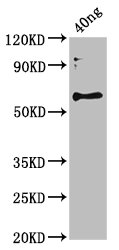botF Antibody
-
货号:CSB-PA341192HA01CLQ
-
规格:¥440
-
促销:
-
图片:
-
其他:
产品详情
-
产品名称:Rabbit anti-Clostridium botulinum botF Polyclonal antibody
-
Uniprot No.:P30996
-
基因名:botF
-
别名:botFBotulinum neurotoxin type F antibody; BoNT/F antibody; Bontoxilysin-F) [Cleaved into: Botulinum neurotoxin F light chain antibody; LC antibody; EC 3.4.24.69); Botulinum neurotoxin F heavy chain antibody; HC)] antibody
-
宿主:Rabbit
-
反应种属:Clostridium botulinum
-
免疫原:Recombinant Clostridium botulinum Botulinum neurotoxin type F protein (1-436AA)
-
免疫原种属:Clostridium botulinum
-
标记方式:Non-conjugated
本页面中的产品,botF Antibody (CSB-PA341192HA01CLQ),的标记方式是Non-conjugated。对于botF Antibody,我们还提供其他标记。见下表:
-
克隆类型:Polyclonal
-
抗体亚型:IgG
-
纯化方式:>95%, Protein G purified
-
浓度:It differs from different batches. Please contact us to confirm it.
-
保存缓冲液:Preservative: 0.03% Proclin 300
Constituents: 50% Glycerol, 0.01M PBS, pH 7.4 -
产品提供形式:Liquid
-
应用范围:ELISA, WB
-
推荐稀释比:
Application Recommended Dilution WB 1:500-1:5000 -
Protocols:
-
储存条件:Upon receipt, store at -20°C or -80°C. Avoid repeated freeze.
-
货期:Basically, we can dispatch the products out in 1-3 working days after receiving your orders. Delivery time maybe differs from different purchasing way or location, please kindly consult your local distributors for specific delivery time.
相关产品
靶点详情
-
功能:Botulinum toxin causes flaccid paralysis by inhibiting neurotransmitter (acetylcholine) release from the presynaptic membranes of nerve terminals of the eukaryotic host skeletal and autonomic nervous system, with frequent heart or respiratory failure. Precursor of botulinum neurotoxin F which may have 2 coreceptors; complex polysialylated gangliosides found on neural tissue and specific membrane-anchored proteins found in synaptic vesicles. Receptor proteins are exposed on host presynaptic cell membrane during neurotransmitter release, when the toxin heavy chain (HC) binds to them. Upon synaptic vesicle recycling the toxin is taken up via the endocytic pathway. When the pH of the toxin-containing endosome drops a structural rearrangement occurs so that the N-terminus of the HC forms pores that allows the light chain (LC) to translocate into the cytosol. Once in the cytosol the disulfide bond linking the 2 subunits is reduced and LC cleaves its target protein on synaptic vesicles, preventing their fusion with the cytoplasmic membrane and thus neurotransmitter release. Whole toxin only has protease activity after reduction, which releases LC. Requires complex eukaryotic host polysialogangliosides for full neurotoxicity. It is not clear whether a synaptic vesicle protein acts as its receptor; there is evidence for and against SV2 fulfilling this function.; Has proteolytic activity. After translocation into the eukaryotic host cytosol, inhibits neurotransmitter release by acting as a zinc endopeptidase that catalyzes the hydrolysis of the '60-Gln-|-Lys-61' bond of synaptobrevin-1/VAMP1 and the equivalent 'Gln-|-Lys' sites in VAMP2 and VAMP3. Cleaves the '48-Gln-|-Lys-49' bond of A.californica synaptobrevin (AC P35589).; Responsible for host epithelial cell transcytosis, host nerve cell targeting and translocation of light chain (LC) into host cytosol. Composed of 3 subdomains; the translocation domain (TD), and N-terminus and C-terminus of the receptor-binding domain (RBD). The RBD is responsible for the adherence of the toxin to the cell surface. It simultaneously recognizes 2 coreceptors; polysialated gangliosides and the receptor protein SV2A, SV2B and SV2C in close proximity on host synaptic vesicles; although not all evidence indicates these are the receptors. The N-terminus of the TD wraps an extended belt around the perimeter of the LC, protecting Zn(2+) in the active site; it may also prevent premature LC dissociation from the translocation channel and protect toxin prior to translocation. The TD inserts into synaptic vesicle membrane to allow translocation into the host cytosol.
-
亚细胞定位:[Botulinum neurotoxin type F]: Secreted.; [Botulinum neurotoxin F light chain]: Secreted. Host cytoplasm, host cytosol.; [Botulinum neurotoxin F heavy chain]: Secreted. Host cell junction, host synapse, host presynaptic cell membrane. Host cytoplasmic vesicle, host secretory vesicle, host synaptic vesicle membrane; Multi-pass membrane protein.
-
蛋白家族:Peptidase M27 family
Most popular with customers
-
-
Phospho-YAP1 (S127) Recombinant Monoclonal Antibody
Applications: ELISA, WB, IHC
Species Reactivity: Human
-
-
-
-
-
-






















